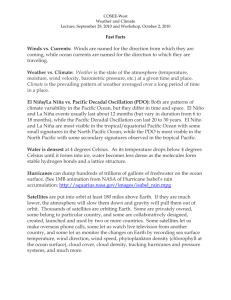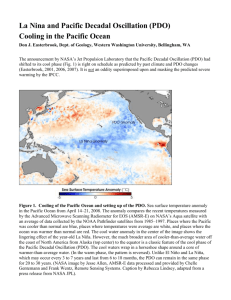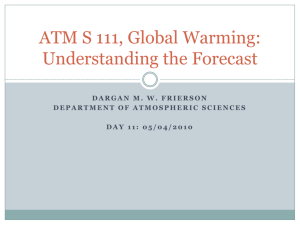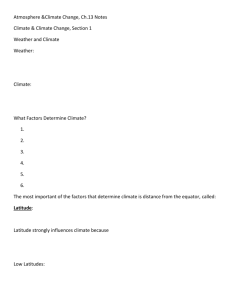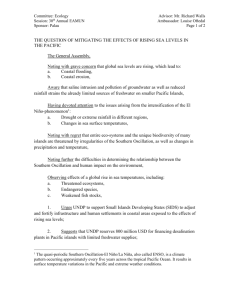G158W12L06_Interannual
advertisement
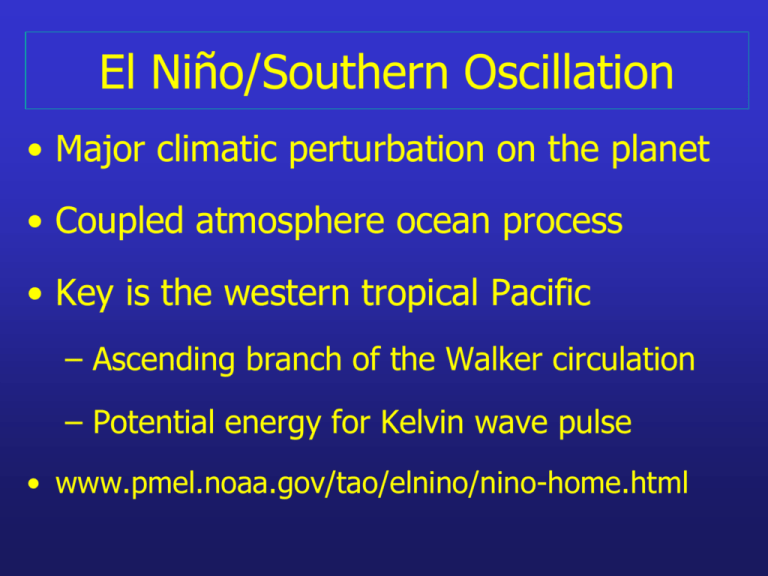
El Niño/Southern Oscillation • Major climatic perturbation on the planet • Coupled atmosphere ocean process • Key is the western tropical Pacific – Ascending branch of the Walker circulation – Potential energy for Kelvin wave pulse • www.pmel.noaa.gov/tao/elnino/nino-home.html Coupled Walker/Ocean Circulation El Niño Conditions Relation of Sea Level with SOI Statistical relationship with SOI Coastal signals seen in CA Current Ted Strub [OSU] San Francisco Sea Level CA Current Effects San Francisco Sea Level Kelvin Wave Pulse Kelvin wave pulse Ted Strub [OSU] Santa Barbara Channel - PnB Santa Barbara Channel Primary Production hn CO2 NUTS O2 Phytoplankton Plants Light, carbon & nutrients make plants & O2 Santa Barbara Channel Santa Barbara Channel Santa Barbara Channel Annual Means – Oct/Oct Year SST (oC) SSS (psu) SSNO3 (mM) SSChl (mg m-3) T(50m) (oC) NO3(50m) (oC) Wind Speed (m s-1) SCR discharge (Mm3/y) 1996 to 1997 15.30 (2.00) 33.62 (0.09) 1.81 (2.30) 2.01 (1.68) 11.48 (0.78) 13.24 (3.93) 7.12 (2.69) 85.00 (466.72) 1997 to 1998 17.35 (5.45) 33.42 (0.20) 0.80 (1.39) 1.05 (1.16) 13.59 (2.35) 7.53 (6.87) 5.99 (2.06) 940.07 (3958.98) 1998 to 1999 14.91 (2.76) 33.5 (0.15) 2.21 (2.76) 2.13 (2.22) 11.18 (1.32) 12.21 (4.48) 7.77 (1.43) 16.30 (51.77) 1999 to 2000 15.36 (1.85) 33.66 (0.12) 1.52 (1.46) 2.74 (2.89) 11.36 (0.97) 11.17 (5.86) 6.70 (2.84) 801.16 (3550.45) 2000 to 2001 15.37 (2.33) 33.58 (0.13) 0.79 (1.07) 1.70 (2.08) 11.24 (0.87) 11.14 (5.23) 6.1 (2.23) 298.68 (1975.85) Total 15.63 (2.46) 33.58 (0.15) 1.42 (1.97) 1.94 (2.20) 11.71 (1.56) 11.14 (5.51) 6.7 (2.32) 435.09 (2597.87) 97/98 ENSO in SB Channel • Deep thermocline & high SST – Limits nitrate supply & chlorophyll biomass – Chl & nitrate are much lower during ESNO • Forcings change – Wind speeds (West channel buoy) are lower – Santa Clara River discharges are >> normal Ocean Color 97/98 ENSO Kahru & Mitchell [2000; GRL] More low Chl regions during ENSO Fewer occurrences of low SST during ENSO Comparisons with the 82-83 ENSO 97/98 ENSO in Central CA • Biological processes are much lower • Winds are roughly the same • Upwelling still happens – but it is less “useful” water upwelling El Niño & CA Current • Kelvin wave pulse propagates north – Propagates 40,000 km in 6 months (2-3 m/s) • Depresses thermocline & raises SST – Thermocline is depressed 30 to 70 m • Winds are not affected in some places not others • Role of thermocline depth is critical – reduced nutrient supply and lower chlorophyll El Niño & Global NPP El Niño & Global NPP El Niño & Global NPP El Niño & NPP • Global primary production rates are a funtion of thermal stratification • Strong relationship with Multi-ENSO Index (MEI) – MEI is like the SOI • Global NPP is related to ENSO Ecosystem Regime Shifts - PDO • Climate oscillators besides ENSO – Pacific decadal oscillation - PDO • Ecosystem effects of “regime shifts” – 1977 (have we flipped back??) – Food web & fishery responses Pacific Decadal Oscillation Warm http://jisao.washington.edu/pdo/ Cool Pacific Decadal Oscillation Southern Oscillation Index • SOI = Tahiti - Darwin air pressure D’s • Low SOI = El Niño conditions Pacific Decadal Oscillation PDO vs. ENSO Pacific Decadal Oscillation Warm Cool http://tao.atmos.washington.edu/pdo/ Southern Oscillation Index • SOI = Tahiti - Darwin air pressure D’s • Low SOI = El Niño conditions Pacific Decadal Oscillation ENSO Pacific Decadal Oscillation Pink Salmon Chum Coho Sockeye Chinook PDO and Salmon Yields September 1972 (National Fisherman 1972) "Bristol Bay [Alaska] salmon run a disaster." "Gillnetters in the Lower Columbia [Washington and Oregon] received an unexpected bonus when the largest run of spring chinook since counting began in 1938 entered the river." 1995 Yearbook (Pacific Fishing 1995) "Alaska set a new record for its salmon harvest in 1994, breaking the record set the year before." "Columbia [Washington and Oregon] spring chinook fishery shut down; west coast troll coho fishing banned." September 1915 (Pacific Fisherman 1915) "Never before have the Bristol Bay [Alaska] salmon packers returned to port after the season's operations so early." "The spring [chinook salmon] fishing season on the Columbia River [Washington and Oregon] closed at noon on August 25, and proved to be one of the best for some years." 1939 Yearbook (Pacific Fisherman 1939) "The Bristol Bay [Alaska] Red [sockeye salmon] run was regarded as the greatest in history." "The [May, June and July chinook] catch this year is one of the lowest in the history of the Columbia [Washington and Oregon]." PDO and Fish Yields PDO and … Mantua et al… Pacific Decadal Oscillation PDO and … salmon stock 1947 step 1977 step western Alaska sockeye -37.2% +242.2% central Alaska sockeye -33.3% +220.4% central Alaska pink southeast Alaska pink -38.3% -64.4% +251.9% +208.7% TABLE 3: Percent change in mean catches of four Alaskan salmon stocks following major PDO sign changes in 1947 and 1977. PDO and … Salmon and the PDO • Two Hypotheses for signal –First feeding of smolts entering ocean & PDO_altered primary production – Streamflow alterations drive salmon habitat availability • Consensus is the first feeding… PDO and … Bristol Bay Salmon Stocks • Studied / Modeled Extensively • Study concluded Biocomplexity preserved by setting regional guidelines– not just protecting economically viable stock • BUT- where does PDO fit in? The largest harvest of sockeye salmon in the world occurs in the Bristol Bay area of southwestern Alaska where 10 million to more than 30 million sockeye salmon may be caught each year during a short, intensive fishery lasting only a few weeks. Freshwater Life: Half of the Cycle Sockeye: “Simply put, the adults spawn at a date that, given the average thermal regime, will allow the embryos to complete embryonic development and emerge in time to feed on aquatic insects and zooplankton the following spring” Hilborn et. al. 2003 Bristol Bay Hydrology & PDO • Above average mean annual discharge warm-PDO • Below average mean annual discharge cool-PDO • In general, high streamflow = favorable reproductive conditions Bristol Bay Catch History Dominant location varies PDO-flux influences general productivity? Stock spawning ground, adaptations influence success of individual runs PDO-related population change not evident in 1920’s to 1940’s? Bristol Bay Stock History Increase in recruits = higher survival rates • Regional Stock have variety of adaptations to mean hydrologic & ecologic conditions Number of recruits per spawner: Total # adult salmon returning from a spawning year divided by # fish spawned in that brood year Pacific Decadal Oscillation Salmon and the PDO PDO Spawners passing Bonneville Dam Hatchery returns PREDICTIONS? • Spring Chinook returns correlated with a “food chain” indicator of ocean conditions, with a two year lag 400 y = 15.5 + 353.0 X 300 p = 0.045, R 2 = 0.26 200 1997/98 El Niño 100 0 -100 -200 past Bonneville Dam two years later Anomaly of counts of adult spring Chinook -300 -0.8 -0.6 -0.4 -0.2 0.0 0.2 0.4 0.6 0.8 Cold Water Copepod Biomass Anomaly Regression curve shown excludes the very high survival years of 1970 and 1973 • 12 1970 R 2 = 0.75 p = 0.0002 10 1969 1973 8 1971 6 4 1972 Ocean Entry 2005 OPI Coho Survival 2 0 -0.8 -0.6 -0.4 -0.2 0.0 0.2 0.4 Northern Copepod Biomass Anomaly 0.6 0.8 Columbia River coho returns correlated with the same indicator but with one year lag A working mechanistic hypothesis: source waters. . . “Cool” Phase Transport of cold water, phytoplankton and boreal zooplankton into the NCC from Gulf of Alaska “Warm” Transport of warm water, phytoplankton and sub-tropical zooplankton into NCC from offshore and from the south Phase Salmon and the PDO • Two Hypotheses for signal –First feeding of smolts entering ocean & PDO_altered primary production – Streamflow alterations drive salmon habitat availability • Consensus is the first feeding… Predicting CA/OR Coho & Chinook Runs for 2012/2013 http://www.nwfsc.noaa.gov/research/divisions/fed/oeip/a-ecinhome.cfm Predicting CA/OR Coho & Chinook Runs for 2012/2013 Predicting CA/OR Coho & Chinook Runs for 2012/2013 Predicting CA/OR Coho & Chinook Runs for 2011/2012 Pacific Decadal Oscillation PDO from Tree Rings Used tree rings from Jeffrey Pine & Douglas Fir Biondi, Gershunov & Cayan, 2001 North Pacific Decadal Climate Variability Since AD 1661. Journal of Climate, 14, 5-10. PDO from Tree Rings Pacific Decadal Oscillation Pacific Decadal Oscillation Pacific Decadal Oscillation • Decadal scale variations in patterns over Pacific • Warm phase – Alaska moist, salmon up (freshwater habitat is good) – Oregon/Washington dry, salmon down – Patterns throughout Pacific basin • Cool phase opposite • Fisheries response (time scales match)

